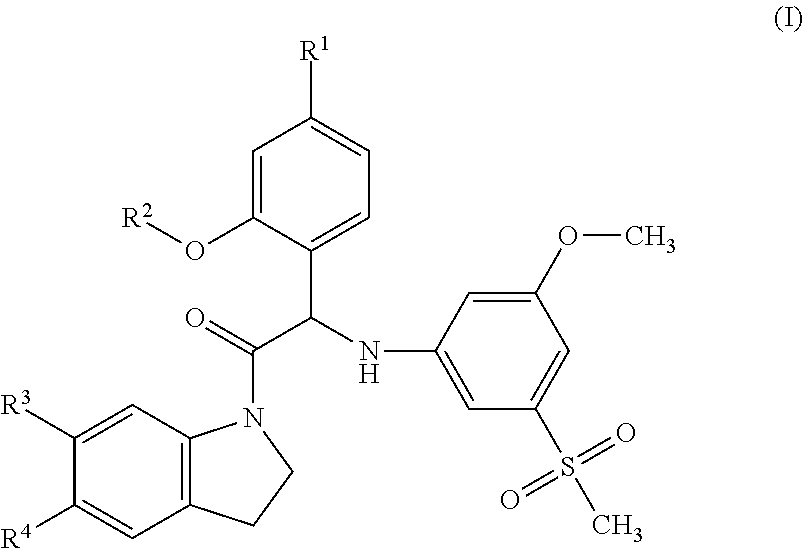Substituted indoline derivatives as dengue viral replication inhibitors
a technology of indoline derivatives and dengue virus, which is applied in the field of substituted indoline derivatives as dengue virus replication inhibitors, can solve the problems of life-threatening infections in man, dhf has become a leading cause of hospitalization and death among children in endemic regions, and the number of dengue cases is increasing, so as to achieve uniform dosage and facilitate administration.
- Summary
- Abstract
- Description
- Claims
- Application Information
AI Technical Summary
Benefits of technology
Problems solved by technology
Method used
Image
Examples
example 1
of 2-(4-fluoro-2-(2-hydroxyethoxy)phenyl)-2-((3-methoxy-5-(methylsulfonyl)phenyl)amino)-1-(6-(trifluoromethyl)indolin-1-yl)ethan-1-one (Compound 1) and Chiral Separation into Enantiomers 1A and 1B
[0063]
[0064]Synthesis of Intermediate 1a:
[0065]A solution of 4-fluoro-2-methoxyphenylacetic acid [CAS 886498-61-9] (10 g, 54.30 mmol) in EtOH (200 mL) and H2SO4 (2 mL) was heated under reflux for 12 h. Water was added and the mixture was concentrated under reduced pressure to half of the original volume. Ice was added, the solution was basified with K2CO3 and extracted with EtOAc. The organic layer was washed with brine, dried over MgSO4, filtered, and the solvent was concentrated under reduced pressure to give ethyl 2-(4-fluoro-2-methoxyphenyl)acetate 1a (11.6 g). The compound was used in the next step without further purification.
[0066]Synthesis of Intermediate 1b:
[0067]Boron tribromide (109.3 mL, 109.3 mmol) was added dropwise to a cooled (−30° C.) solution of ethyl 2-(4-fluoro-2-methoxy...
example 2
of 2-(4-fluoro-2-(2-hydroxyethoxy)phenyl)-2-((3-methoxy-5-(methylsulfonyl)phenyl)amino)-1-(5-methoxy-6-(trifluoromethyl)indolin-1-yl)ethanone (Compound 2) and Chiral Separation into Enantiomers 2A and 2B
[0097]
[0098]Synthesis of Intermediate 2a:
[0099]To a mixture of ethyl 2-(4-fluoro-2-hydroxyphenyl)acetate 1b (10.6 g, 53.5 mmol) and cesium carbonate (34.8 g, 106.9 mmol) in DMF (200 mL) at 10° C. was added (2-bromoethoxy)(tert-butyl)dimethylsilane [CAS 86864-60-0] (13.8 mL, 64.2 mmol). The reaction mixture was stirred at room temperature overnight. H2O was added and the reaction mixture was extracted with EtOAc. The organic phase was dried over MgSO4, filtered and concentrated under reduced pressure. The residue was purified by flash chromatography on silica gel (15-40 μM, 40 g, heptane / EtOAc 80 / 20). The pure fractions were combined and the solvent was removed under reduced pressure to give ethyl 2-(2-(2-((tert-butyldimethylsilyl)oxy)ethoxy)-4-fluorophenyl)acetate 2a (17.7 g).
[0100]S...
example 3
of 2-(4-fluoro-2-(2-hydroxyethoxy)phenyl)-2-((3-methoxy-5-(methylsulfonyl)phenyl)amino)-1-(6-(trifluoromethoxy)indolin-1-yl)ethanone (Compound 3) and Chiral Separation into Enantiomers 3A and 3B
[0132]
[0133]Synthesis of Intermediate 3a:
[0134]To a solution of 2-(2-(2-((tert-butyldimethylsilyl)oxy)ethoxy)-4-fluorophenyl)-2-((3-methoxy-5-(methylsulfonyl)phenyl)amino)acetic acid 2d (1 g, 1.90 mmol) in DMF (10 mL) were added HATU (1.08 g, 2.84 mmol), diisopropylethylamine (940 μL, 5.69 mmol) and 6-(trifluoromethoxy)indoline [CAS 959235-95-1] (385 mg, 1.90 mmol). The reaction mixture was stirred at room temperature for 4 h. The reaction mixture was diluted with water. The precipitate was filtered off, washed with water and taken up with EtOAc. The organic layer was washed with a 10% solution of K2CO3 in water, a saturated solution of NaCl in water, water, dried over MgSO4, filtered and the solvent was concentrated under reduced pressure to give 2-(2-(2-((tert-butyldimethylsilyl)oxy)ethoxy)...
PUM
| Property | Measurement | Unit |
|---|---|---|
| pressure | aaaaa | aaaaa |
| temperature | aaaaa | aaaaa |
| wavelength | aaaaa | aaaaa |
Abstract
Description
Claims
Application Information
 Login to View More
Login to View More - R&D
- Intellectual Property
- Life Sciences
- Materials
- Tech Scout
- Unparalleled Data Quality
- Higher Quality Content
- 60% Fewer Hallucinations
Browse by: Latest US Patents, China's latest patents, Technical Efficacy Thesaurus, Application Domain, Technology Topic, Popular Technical Reports.
© 2025 PatSnap. All rights reserved.Legal|Privacy policy|Modern Slavery Act Transparency Statement|Sitemap|About US| Contact US: help@patsnap.com



